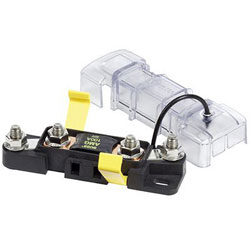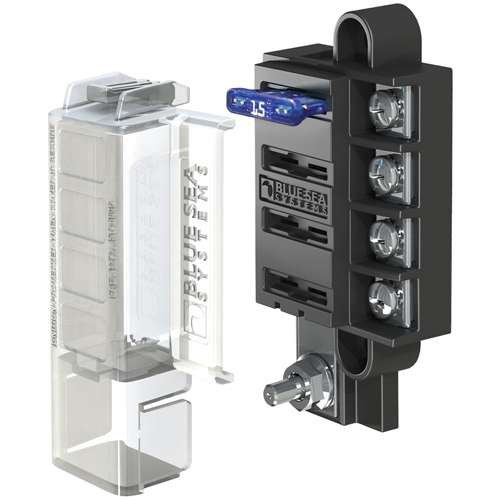Facts About Blue Sea Fuse Block Revealed
Wiki Article
How Blue Sea Fuse Block can Save You Time, Stress, and Money.
Table of ContentsThe Best Guide To Blue Sea Fuse BlockThe Facts About Blue Sea Fuse Block UncoveredAll About Blue Sea Fuse BlockThe Ultimate Guide To Blue Sea Fuse BlockIndicators on Blue Sea Fuse Block You Should KnowHow Blue Sea Fuse Block can Save You Time, Stress, and Money.
Fuses are bolted in location in between the bus bar and also the second collection of electrically separated bolts. With this installation you can attach the watercraft's different high-current circuits, such as a windlass, bow thruster, high-output alternator, the DC panel, etc, to the isolated bolts. The numerous integrates are sized according to the current-carrying capacity of the conductors bolted to them.Some circuits will still need to bypass the isolation button to make sure that they may be left on when the remainder of the watercraft is closed down. blue sea fuse block. These circuits usually include a bilge pump and any kind of billing devices (including solar panels, possibly a wind generator, and the inverter if it likewise doubles as a battery charger).
This is part of the circuit representation we created for the complex instance watercraft in our Boat Electrics training course. The tools attached to the fuse block in the top right are all bypassing the isolation switch S1. If you register for Watercraft Electrics 101, you will learn how to check out such a representation and also just how to make one for your own watercraft.
Blue Sea Fuse Block Fundamentals Explained

The goal is to supply defense at the resource of power for every circuit. With DC circuits, the OCP is always placed in the favorable side of DC circuits. (Aside from anything else, an unbroken connection to DC negative should be kept in all times to secure against stray-current corrosion.) Keep in mind that some European boatbuilders install fuses as well as battery switches in the DC unfavorable side as well as on the silver lining, but this is not recommended other than in some separated (drifting) ground DC systems.
This factor may go to the battery, the battery switch, the circulation panel, a subsidiary panel, some distribution bus bar, or various other connecting point. If the conductors in the new circuit are no smaller than the conductor that feeds the brand-new circuit's factor of connection, then the OCP for the feeder conductor will completely safeguard the brand-new circuit - blue sea fuse block.
Blue Sea Fuse Block Fundamentals Explained
Yet if the new circuit is not properly offered by overcurrent gadgets currently in place, added defense is called for at its point of link, i. e., at its resource of power. Placement of fuses in the favorable conductor. Keep in mind how a smaller fuse is utilized every single time a smaller sized conductor is attached, Occasionally space limits how close an OCP gadget can click to investigate be positioned to the resource of power.The generic response, from the ABYC, is within 7" (17. The ABYC permits the complying with, which have actually been tightened up in recent years: A conductor connected directly to a battery that is likewise "included throughout its whole range in a sheath or enclosure such as a channel, junction box, control box or encased panel" need to have its overcurrent defense "as close as practicable to the battery, yet not to go beyond 72 inches (1.
Gone is the covering 72" allocation that used to be there. A conductor connected to a source of power aside from the battery (e. g., the battery button, the circulation panel, or a few other factor in the DC circuits) that is in a similar way Discover More Here included in a sheath, and so on, must have its overcurrent protection "as close as achievable to the point of link to the source of power, but not to exceed 40 inches (1.
Blue Sea Fuse Block for Beginners
e., anywhere it connects into the DC system. Given that generators themselves are a source of power, it has been debatable whether these added generators needed OCP at the generator itself. This has been fixed in the most up to date variation of the ABYC E-11 criterion as adheres to: "Overcurrent security is not called for at a generator if the ampacity of the conductor amounts to or higher than the rated result of the alternator."Cranking-motor circuits are not needed to have overcurrent defense.In the aquatic field, where cranking circuits might be long, this practice could produce a threat. It makes no sense to have any kind of unprotected circuits on a boat.
In winter, the inrush present on a 12V starter motor might be as high as 1,500 amps; the cranking current may be as high as 200 amps. Commonly, cranking conductors are undersized also for the cranking existing, let alone the inrush existing. This situation does not posture a safety issue per se, due to the fact that these currents are sustained for just a couple of secs, so the conductors do not have time to obtain warm sufficient to produce a fire hazard.
Not known Facts About Blue Sea Fuse Block
If you desire to discover how to wire a boat, detailed in 56 video lessons, have a look at our Boat Electrics 101 program. We made the training course with outright newbies in mind. As the electrical tons on boats boosts, so also does the complexity of electrical circuits as well as the possibility for brief circuits and also electrical fires.
In the marine field, where cranking circuits might be long, this technique might develop a risk. If an automobile ignites, the occupants can pull over as well as jump out. If a boat captures fire, it is not so straightforward. It makes no sense to have any type of unguarded circuits on a watercraft.
Rumored Buzz on Blue Sea Fuse Block

If you intend to discover how to wire a watercraft, step-by-step in 56 video clip lessons, take a look at our Watercraft Electrics 101 program. We made the course with outright beginners in mind. As the electric load on watercrafts increases, so as well does the intricacy of electrical circuits as well as the potential for brief circuits and electrical fires.
Report this wiki page